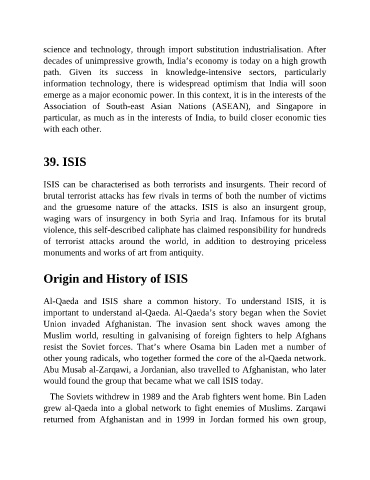Page 632 - SSB Interview: The Complete Guide, Second Edition
P. 632
science and technology, through import substitution industrialisation. After
decades of unimpressive growth, India’s economy is today on a high growth
path. Given its success in knowledge-intensive sectors, particularly
information technology, there is widespread optimism that India will soon
emerge as a major economic power. In this context, it is in the interests of the
Association of South-east Asian Nations (ASEAN), and Singapore in
particular, as much as in the interests of India, to build closer economic ties
with each other.
39. ISIS
ISIS can be characterised as both terrorists and insurgents. Their record of
brutal terrorist attacks has few rivals in terms of both the number of victims
and the gruesome nature of the attacks. ISIS is also an insurgent group,
waging wars of insurgency in both Syria and Iraq. Infamous for its brutal
violence, this self-described caliphate has claimed responsibility for hundreds
of terrorist attacks around the world, in addition to destroying priceless
monuments and works of art from antiquity.
Origin and History of ISIS
Al-Qaeda and ISIS share a common history. To understand ISIS, it is
important to understand al-Qaeda. Al-Qaeda’s story began when the Soviet
Union invaded Afghanistan. The invasion sent shock waves among the
Muslim world, resulting in galvanising of foreign fighters to help Afghans
resist the Soviet forces. That’s where Osama bin Laden met a number of
other young radicals, who together formed the core of the al-Qaeda network.
Abu Musab al-Zarqawi, a Jordanian, also travelled to Afghanistan, who later
would found the group that became what we call ISIS today.
The Soviets withdrew in 1989 and the Arab fighters went home. Bin Laden
grew al-Qaeda into a global network to fight enemies of Muslims. Zarqawi
returned from Afghanistan and in 1999 in Jordan formed his own group,

